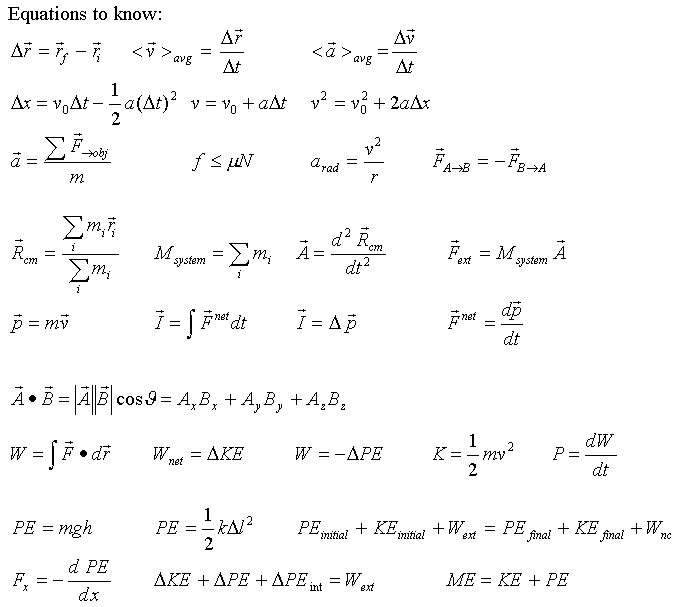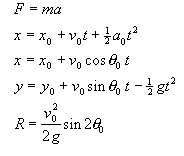
Contents
1. Some comments
2. What will be on the test
3. Equation sheet
4. Test format
5. Examples of questions
1. Some comments
On problems, it is important to show how you reasoned from the information given in the problem to your final answer. The correct final answer with units is only worth 2-3 points. The remainder of the points are given for the quality of your solution. You need to include the following to receive full credit:
- All the information given in the problem with correct units (This may include a diagram)
- A statement of what quantity you are trying to find.
- State explicitly what physics principle you are using to solve the problem
- Solve for the unknown quantity in symbols explicitly before numberic calculations
- Then substitute numbers with units and calculate the numeric answer
Extra credit will be given for checks made to see if the answer is reasonable
Be prepared to make reasonable estimations and state your assumptions when solving problems. Be aware of significant digits in your answers. (Keep lots of digits until the final calculation, then round to the appropriate precision.)
Here are some really good tips on test taking from Dr. Richard Felder's website at North Carolina State University.
If you have ANY questions while taking the test, please be sure to ask the instructor. The purpose of the test is not to give you trick problems to catch you in an error. The purpose is to give you an opportunity to "show what you know" ! The test problems are based completely on the reading, the lectures, and the homework. If you understand the main ideas and how to apply them, you'll do well.2. What will be on the test
Be sure to carefully review your notes, especially when we do things that are not covered very well in the book. Looking over the individual class days linked to the calendar on the class website will also help refresh your memory. Although this test is comprehensive, the test will emphasize material from chapters 3, 4, & 5.
For this test, you should be able to do the following things:
Chapter 0 Measurement, Estimation, and Units
Chapter 1 Concepts of Motion
Chapter 2 (Vectors & Coordinate Systems)
Chapter 3 Kinematics: The Mathematics of Motion
Chapter 4 Force and Motion
Chapter 5 Dynamics I: Newton's 2nd Law
Chapter 6 Dynamics II: Dynamics in a Plane
Chapter 7 Dynamics III: Newton's Third Law
Chapter 8 Momentum and Its Conservation
Chapter 9 Concepts of Energy I: Work and Energy
Chapter 10 Concepts of Energy II: Potential Energy and Energy Conservation
Equations:You will need to know the following equations and under what conditions they can be applied:

Should also know formulas for:
Conversions (rules of thumb):
Numbers to know:
You will need to be able to derive specific equations you need from these equations listed above. You will also be given any additional constants and conversions you need. Unless told otherwise, you may use - 10 m/s/s for the acceleration due to gravity.
4. Test Format:
From 4-7 PM on Friday, December 7, 2001 or by private arrangements with Dr.
Saul (Except for extreme illness or emergencies, private arrangments must be
finalized by Wednesday, December 5th).
| Part I |
(30 points)
|
|
|
| Part II |
(95 points)
|
| Problem 1: Multiple Choice or short answer
question, typically 8-10 parts (no explanation required, but no partial credit either) |
25-30 points |
| Problem 2: Estimation Problem | 20 points |
| Problem 3: Short Essay ( Mainly looking for an answer in words - about a 1/2-1 page paragraph, but equations, diagrams, and graphs OK. No calculations allowed) |
15 points |
|
Problems 4 & 5: 2 Problems based on Homework
and Lecture
(15-20 points each) |
30 - 35 points
|
| Part III |
(25 points)
|
|
25 points
|
|
|
150 points
|
If the overall test average of your entire group is 75% or above, every member of your group will receive a bonus of 5%.
Bonus points for problems 2,4, & 5 are awarded for showing work to check your answer for reasonableness or for using GOAL.
Note: Many of you commented that you ran out of room on the first test. The Final Exam will be printed single sided so this should not be a problem. Use the back of the previous page if you need more space
6. Some Practice Questions
Essay Questions
1) The conservation of momentum is useful in some situations and not in others. Describe how you obtain the impulse-momentum theorem from Newton's second law and what situations lead to momentum conservation. How would you decide if conservation of momentum could be used in a particular problem?
2) Energy conservation is sometimes a useful principle in helping us solve problems concerning the motion of objects. Suppose a single object is moving subject to a number of forces. Describe how you would know whether energy conservation would hold for the given example and in what kinds of problems you might find it appropriate to use it.
3) Discuss the difference between the physical content of the two laws F = ma and F = mg. (Do NOT just give a one sentence statement describing each. Think about what they mean and how they are used. Are they similar in some ways? Are they different in some ways? What I am looking for here is a thoughtful discussion that shows some insight into what these laws mean.)
4) Student A says: Galileo said all objects fall with the same speed. I know that's not true. If I drop a balloon and a billiard ball the balloon falls more slowly. Galileo was wrong.
Student B says: No. Galileo only said two heavy objects fall with the same speed. If I drop a steel ball and a wooden ball they hit the ground at the same time.
Discuss these student's statements. Which one do you agree with? If either or both are wrong, explain why.
5) In our readings about mechanics we encounter the following equations:
For each equation, discuss the following questions:

Sketch on your paper a diagram in which you put each of the equations in a box. Connect with an arrow any pair of equations when one equation can be easily derived from another by considering a special case. (The arrow should point from the more general to the more specific equation.)
Estimation Questions
1) The mass of the earth is about 6x10^24 kg. Estimate the kinetic energy it has as a result of its orbiting the sun.
2) According to some recent highly accurate measurements made from satellites, the continent of North America is drifting at a rate of about 1 cm per year. Assuming a continent is about 50 km thick, stimate the kinetic energy the continental US has as a result of this motion.
3) For next year's Physics Open House, the Department is planning to set up
a bungee jump from the top of the physics building. Assume that one end of an
elastic band will be firmly attached to the top of
the building and the other to the waist of a courageous participant. The participant
will step off the edge of the building to be slowed and brought back up by the
elastic band before hitting the ground
(we hope). Estimate the length and spring constant of the elastic you would
recommend using.
4) Suppose an elevator with a mass of 1000 kg lifts 3 people from the 2nd to the 4th floor of a building. The elevator is connected by a cable to an electric motor at the top of the shaft.
5) Suppose you are visiting some relatives in Maryland during winter break
when you are hit by a snow storm. You offer to shovel the walk but your host
tells you not to bother since you are not used to it. Estimate the amount of
work your host does shoveling the walk after a snow storm. Among your estimates,
you may use the following:
- The length of a typical path from a house to a street is 10 meters.
- Assume the snow fell to a depth of 4 inches
- Assume the snow was only moderately packed so that its density was equal to
0.2 g/cm3 - about one fifth that of water.
In doing this problem, you should estimate any other numbers you need to one
significant figure. Be certain to state what assumptions you are making and
to show clearly the logic of your calculation.